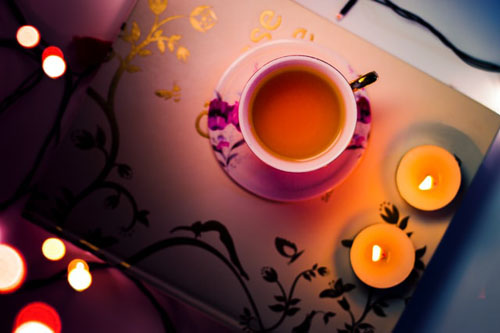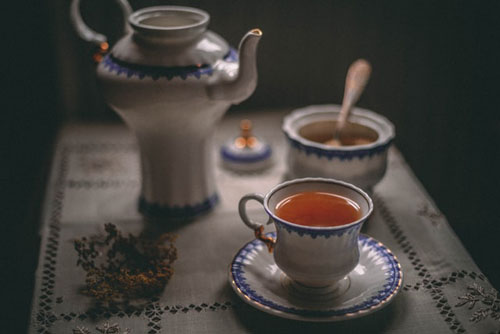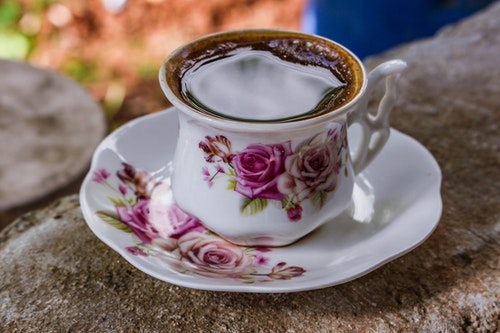
Darjeeling tea is certainly one of the most unique teas grown in India. It is unbeatable when it comes to taste.
I visited the Darjeeling district quite often as a child and got to taste Darjeeling black tea many a time which helped to develop my palate. Now, I will give you an in-depth introduction into this tea including what makes it so special and how to prepare your very own cup. Let's begin!
Contents
When most people refer to Darjeeling teas, it is as though they are speaking about an entirely separate type of tea. However, is this is the case? No, not really. Darjeeling falls under the category of black tea. It derives its name from the region in West Bengal, India near where the tea plants are grown.
OK, if Darjeeling is just black tea, what really sets this blend apart from the rest? Most people will tell you that Darjeeling teas are unique because of their flavor and they would be correct - to a certain extent. In reality, what makes these teas popular are the factors involved in the growing and harvesting of tea leaves. These include:
Another interesting factor is the variety of tea leaves that produce this blend. Let's break this unusual feature down a little further.

The first thing that you need to be aware of is that there are actually two different types of tea plants. Now, they both come from the same family - Camellia sinensis. However, there is a Chinese variety - Camellia sinensis var. sinensis and an Indian one - Camellia sinensis var. assamica.
As you will have guessed, most of the teas grown in Indian tea gardens come from the Indian Assam variety. However, Darjeeling tea is an exception to this rule. This is because a combination of unique soil conditions and weather ensures that this is the only place outside of China and Japan that this tea plant variety can grow. Therefore, you may find that the Darjeeling region is sometimes known as the Champagne region. This is because it is known for producing such high quality teas.
The one thing that people always seem to discuss when talking about Darjeeling is flushes. What on earth does this mean and what kind of impact does it have on your tea? Flushes are just another word for harvests. Darjeeling teas have four flushes, which means that there are four harvest periods. These are as follows:
First, flush teas are actually prized quite a bit as the leaves are fresh and new. At this point, two leaves and a bud are selected through Early February, all the way to April. The leaves aren't oxidized as much after this season, either. The early leaves lend a light and fresh flavor to the leaves. You will often find that the resulting drink is quite light in color - almost like green tea. First, flush tea is considered to be the epitome of quality and is often referred to as the Champagne of teas by tea experts.
Spring Flush teas may be considered the champagne option, but the second flush tea certainly shouldn't be ignored. In fact, the flavors produced by this period - which runs through April, May, and June - do tend to be more characteristic of what people consider Darjeeling flavor. As such, it is quickly becoming the more popular option. Not to mention, it is more affordable as well.

The continuous rainfall during July, August, and September cause the leaves to grow thick and quickly. Unfortunately, this does lend to a more muted flavor. Due to this, third flush tea is actually considered to be of lower quality. It is often blended together with other types of black tea to create a cheaper version of Darjeeling. You will often find these leaves for iced tea blends.
Last, but certainly not least, there is the autumnal flush that takes place during October and November. As the growth is now less, this season is actually considerably shorter and often doesn't last more than a month. However, these tea leaves produce a drink that a deep-bodied, complex - a truly exceptional cup. As a result, it is a favorite among tea connoisseurs.
Of course, what you are really interested in is what the tea actually tastes like. Thus, here is a breakdown of the flavors based on when they were harvested:
You should bear in mind that a lot of different factors can impact the flavor of the tea. This includes genetics, where the plants are grown, the climate, and even the surrounding insects. Thus, there can be quite a bit of discrepancy in how the tea tastes.
If you want to enjoy the exquisite and unique flavor of each flush, then it is important to invest in the highest grade possible. Look for a brand that offers traditional harvest and processing methods. This will ensure that the complexities of the tea is maintained. And, as always, loose leaf teas do produce tastier beverages.
Here are the main health benefits associated with Darjeeling tea:
Did you know that a number of chronic diseases are a direct result of inflammation in the body? Thus, it is certainly an advantage that Darjeeling tea contains antioxidants that fight free radicals that can damage cells. Thus, there could be a lower risk of health concerns such as arthritis. And, although Darjeeling doesn't have as much of antioxidant capacity as green tea, there is a chance that it could potentially work to reduce the risk of cancer as well.
There is also some evidence that the flavonoids and polyphenols in the leaves can help to negate factors that can lend themselves to atherosclerosis. In turn, this can potentially reduce your risk of developing high blood pressure as well as more serious issues such as strokes.
A lot of people struggle with proper hydration as they don't much care for water. And, other drinks like juices and sodas aren't great options. Darjeeling tea, on the other hand, is a healthy alternative to water. As it tastes quite good, this makes it easier for people to drink more of it and to eliminate toxins in the process. Also, since Darjeeling tea has no calories, it can be added to a weight loss diet as well. You can drink a cup before meals or in between meals to help you feel fuller and to avoid snacking as much.

As Darjeeling is a type of black tea, it does contain caffeine. It is estimated that there is about 50mg per 8-ounce cup. However, the exact caffeine content can differ from one brand to another. Some may contain less while others may contain a lot more.
You should also know that brewing methods can impact the caffeine content in your cup. For instance, brewing tea with hotter water or steeping the leaves for longer, can result in a more caffeinated drink. In terms of comparison, Darjeeling tea has more caffeine than green tea, white tea, and oolong tea. However, it contains less than Assam and masala chai black tea as well as coffee.
Finally, you need to know how to prepare Darjeeling tea. You should add about a tablespoon of loose tea to 8 ounces of water. While loose tea does provide the best flavor, you can also use a teabag. One bag per cup should suffice.
Heat the water until it just begins to boil and remove it from the stove. Then pour the water into the cup or container with the loose leaf tea. Allow the leaves to steep for between 1 to 5 minutes. After the 1 minute mark, begin to taste your tea to determine which strength is most preferable to you. Drain the leaves and enjoy your tea while it is warm.
It is important to never add milk or sugar to your tea. On its own, the leaves produce a delicious cup. Any other ingredients will ruin the complex profile of the Darjeeling tea. If you aren't impressed with the taste, make an effort to find a type that will match the level of sweetness, flowery, or fruity taste that you are looking for.
This is your ultimate guide on all things Darjeeling. As you can see, there is just so much to learn about this subject and all the facts are equally fascinating!
If you enjoyed this post make sure to check out our Pinterest profile. We have tons of other articles and posts on all types of tea.
